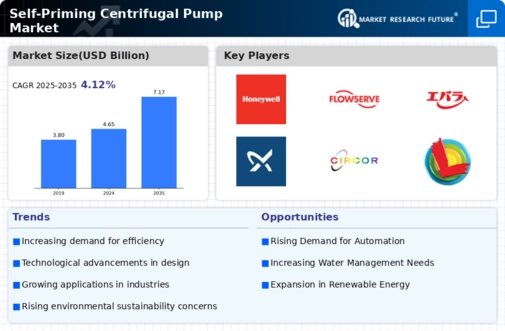Technological Innovations
The Self-Priming Centrifugal Pump Market is benefiting from rapid technological innovations. Advances in pump design and materials have led to enhanced efficiency and reliability. Manufacturers are increasingly integrating smart technologies, such as IoT capabilities, into their products, allowing for real-time monitoring and maintenance. This trend not only improves operational efficiency but also reduces downtime and maintenance costs. The introduction of energy-efficient models is also noteworthy, as they align with global sustainability goals. The market is expected to see a surge in demand for these innovative solutions, with projections indicating a growth rate of 6% in the coming years.
Rising Demand in Agriculture
The Self-Priming Centrifugal Pump Market experiences a notable increase in demand from the agricultural sector. As irrigation practices evolve, the need for efficient water management systems becomes paramount. Self-priming centrifugal pumps are favored for their ability to handle varying water levels and maintain consistent flow rates. In recent years, the agricultural sector has seen a shift towards more sustainable practices, which often require reliable pumping solutions. The market for these pumps in agriculture is projected to grow at a compound annual growth rate of approximately 5.2% over the next few years, driven by the need for efficient irrigation systems and the increasing adoption of modern farming techniques.
Increased Focus on Water Management
The Self-Priming Centrifugal Pump Market is witnessing a heightened focus on water management solutions. As water scarcity becomes a pressing issue, efficient water distribution systems are essential. Self-priming centrifugal pumps are recognized for their ability to operate effectively in low-water conditions, making them ideal for various applications, including municipal water supply and irrigation. The market is projected to expand as governments and organizations invest in water management infrastructure. Recent initiatives indicate that investments in water management technologies are expected to reach USD 1 trillion by 2027, highlighting the potential for growth in the self-priming pump segment.
Growing Demand in the Chemical Industry
The Self-Priming Centrifugal Pump Market is experiencing a surge in demand from the chemical industry. As the production of chemicals and petrochemicals increases, the need for reliable and efficient pumping solutions becomes critical. Self-priming centrifugal pumps are particularly suited for handling viscous fluids and slurries, making them indispensable in chemical processing applications. Recent market analysis suggests that the chemical sector is projected to grow at a rate of 4% annually, which will likely drive the demand for self-priming pumps. This growth presents opportunities for manufacturers to cater to the specific needs of the chemical industry, enhancing their market presence.
Industrial Growth and Infrastructure Development
The Self-Priming Centrifugal Pump Market is significantly influenced by the ongoing industrial growth and infrastructure development. As industries expand, the demand for reliable fluid transfer solutions rises. Self-priming centrifugal pumps are essential in various applications, including water supply, wastewater management, and chemical processing. The construction of new facilities and the upgrading of existing infrastructure contribute to the increasing need for these pumps. Recent data indicates that the industrial sector is expected to grow by 4.5% annually, further propelling the demand for self-priming pumps. This growth is likely to create opportunities for manufacturers to innovate and enhance their product offerings.


















Leave a Comment